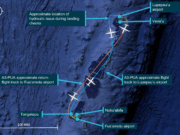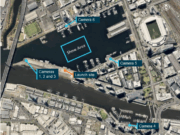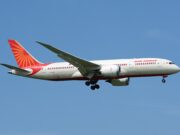
The following information provides an awareness of problems that might be avoided in the future. The information is based on final reports by official investigative authorities on aircraft accidents and incidents.
 Jets
Jets
Tow Vehicle Unmonitored
Boeing 737, ATR 42. Substantial damage. No injuries.
Last-minute actions by the pilot of a 737-800 rolling at high speed for takeoff and by a tow-vehicle driver who inadvertently towed an ATR 42-600 onto the active runway avoided what could have been a fatal head-on collision. Nevertheless, both aircraft were substantially damaged by a glancing blow as the pilot and the tow-vehicle driver maneuvered to opposite sides of the runway centerline.
The collision occurred at Jakarta, Indonesia, the night of April 4, 2016. Both aircraft were parked on the airport’s north ramp. The 737 was being readied for a flight to Makassar with 49 passengers and seven crewmembers, while the tow-vehicle driver and an assistant prepared to reposition the ATR to the south ramp. The assistant’s task was to communicate via hand signals to two engineers in the ATR’s cockpit if manual braking was required.
At 1948 local time, the 737 flight crew was cleared by the airport tower controller to taxi to Runway 24 for departure. At the same time, the tow-vehicle driver, using a handheld radio tuned to a different frequency, was cleared by an assistant controller to follow the 737. “The clearance was given without a specific route to be followed and explicit clearance to cross or to hold short of the runway,” said the report by the Indonesian National Transportation Safety Committee (KNKT).
The report said that the 737 crew did not know that an aircraft was being towed behind them. The tow vehicle’s headlights and roof-mounted rotating beacon were illuminated, but the only lights on the ATR were portable units installed on the wing tips.
Due to the layout of the airport taxiways, the 737 crew was required to back-taxi on the runway so that they could use the full length for takeoff. The assistant controller was coordinating with another airport service unit when the tow-vehicle driver followed the 737 onto the runway and began to drive down the centerline.
No one saw that the tow vehicle was on the runway when the 737 began its takeoff roll. The report said that bright lights at the approach threshold of Runway 24 affected the flight crew’s forward vision and that reflections on the control tower’s windows diminished the controllers’ ability to see obstructions on the runway.
When the tower cleared the 737 crew for takeoff, the distance between the tow vehicle and the 737 was about 600 m (1,969 ft). The aircraft was accelerating through 115 kt when the copilot, the pilot flying, saw “an object” ahead. He rejected the takeoff and maneuvered the 737 to the right of the runway centerline.
Meanwhile, the tow-vehicle driver had seen the 737 begin its takeoff roll and had started to turn off the right side of the runway. The tow vehicle was on the grass, with the ATR positioned at about a 45-degree angle to the right of the runway centerline, when the collision occurred. The 737’s left wing struck the ATR’s left wing and severed the tail section. The 737 then came to a stop on the runway. Despite the damage, none of the occupants of the 737, the tow vehicle or the ATR were injured.
The KNKT concluded that factors contributing to the collision included the “handling of two movements in the same area with different controllers on separate frequencies without proper coordination” and “the lighting environments in the tower cab and turning pad area of Runway 24.”
Aged Windshield Cracks
Airbus A319-112. Minor damage. No injuries.
About an hour after departing from Orlando, Florida, U.S., for a flight to Las Vegas, Nevada, the night of May 4, 2015, the flight crew saw electrical arcing and sparks along the bottom of the copilot’s windshield. “The flight crew then heard a popping sound and observed the windshield cracking,” said the report by the U.S. National Transportation Safety Board (NTSB).
The crew also saw smoke in the cockpit. They declared an emergency and diverted to New Orleans, Louisiana, where the A319 subsequently was landed without further incident. None of the 131 passengers and five crewmembers was hurt.
“Post-incident examination of the windshield revealed evidence of repairs to the moisture seal along the windshield’s entire upper and aft edges, and the windshield exhibited typical signs of aging,” the report said. “Evidence of moisture ingression into the laminate around the edges of the windshield was found.”
The report said that the moisture eventually had reached the bus bar while the windshield heat was engaged and had caused the electrical arcing and cracking of the outer windshield pane.
The windshield, which had accumulated 38,085 hours since installation, had undergone a periodic inspection eight days before the incident. The inspection revealed damage that was not sufficient to require replacement of the windshield. “The delamination, discoloration, interlayer microflakes, bubbling and burn spots [found during the inspection] were within the specified limits of the airplane maintenance manual,” the report said.
Crushed Ped Emits Smoke
Airbus A380. Minor damage. No injuries.
En route from Sydney, Australia, the night of May 16, 2016, the A380 was about two hours from the destination in Dallas, Texas, U.S., when a passenger alerted cabin crewmembers about smoke in the cabin. “The cabin crew then initiated the basic fire drill,” said the report by the Australian Transport Safety Bureau (ATSB).
The crew found that the smoke was emerging from a center-row seat on the A380’s upper deck. They turned off electrical power to that row and began dismantling the seat. “The crew found a crushed personal electronic device (PED) wedged tightly in the seat mechanism,” the report said. “The PED was no longer emitting smoke; however, a strong acrid smell remained in the cabin.”
The crew freed the PED from the seat, placed it in a jug of water and put the jug in a metal box, which was monitored for the duration of the flight.
Investigators found that the fire likely originated from a “thermal event” in the PED’s lithium battery. “This incident highlights the hazards of transporting lithium-ion battery–powered PEDs,” the report said. “The ATSB has received 17 notifications of similar incidents of lithium battery thermal events in aircraft over the past six years.”
Loose Squat Switches
Learjet 35A. Substantial damage. No injuries.
Mechanics at a contract maintenance facility, the Learjet operator’s mechanic and the pilots all failed to notice that the landing gear squat switches had not been reattached properly after maintenance was performed on the airplane in Grand Junction, Colorado, U.S., according to the NTSB.
The squat switches normally are closed during ground operations to allow application of reverse thrust, nosewheel steering and manual braking. The switches open on takeoff to prevent the use of these systems in flight.
The loose squat switches caused no problems when the pilots began the post-maintenance positioning flight from Grand Junction to McMinnville, Oregon, the afternoon of May 13, 2013. “The brakes and steering were working during taxi before departure, but this was most likely because either one or both of the switches were making partial contact at that time,” the NTSB report said.
However, the loose switches apparently detached completely during the flight, rendering the thrust reversers, nosewheel steering and manual brakes inoperative when the Learjet was landed at McMinnville. “As the airplane approached the end of the runway, the pilot activated the emergency braking system,” the report said. “However, the airplane overran the end of the runway, coming to rest in a ditch.” The two pilots and the operator’s mechanic were not injured, but the Learjet’s wings and fuselage were substantially damaged.
 Turboprops
Turboprops
Control Lost on Approach
Beech King Air C90GTx. Destroyed. Three fatalities.
Night instrument meteorological conditions and thunderstorm activity prevailed in the area when the King Air departed from Rand Airport in Germiston, South Africa, for a short flight to Lanseria Airport in Johannesburg to clear customs for a subsequent business flight to Zambia on Feb. 3, 2014.
Visibility was 800 m (1/2 mi) and the ceiling was overcast at 800 ft when the pilot was cleared to conduct the VOR (VHF omnidirectional range) approach to Runway 07, the only instrument approach available at Lanseria Airport, said the report by the South African Civil Aviation Authority.
When the King Air reached the missed approach point (MAP), the runway was not in sight, and the pilot initiated a go-around. The airport tower controller advised that better weather prevailed at another airport with customs facilities, but the pilot said he would attempt another VOR approach at Lanseria and then divert if necessary.
During the second approach, the pilot reported the field in sight at the MAP and was cleared to land. Soon thereafter, however, the pilot radioed that he no longer had the runway in sight and that the aircraft was in distress, the report said. The controller then heard a loud bang and saw black smoke emerge from behind a hangar.
Investigators found that the pilot had lost control of the aircraft, which stalled and entered a rapid descent. The pilot and his two passengers were killed when the King Air subsequently struck terrain.
Misaligned Touchdown
British Aerospace ATP. Substantial damage. No injuries.
The cargo aircraft was descending to land at Wamena, Papua, Indonesia, the morning of May 31, 2013, when the airport traffic controller told the flight crew that visibility was 4 km (2 1/2 mi) and the winds were calm. The pilots then proceeded to fly an unstabilized visual approach, the KNKT report said.
Investigators determined that the ATP was 500 ft above ground level (AGL) when the crew, in response to a query by the controller, reported that they were on final approach and did not have the runway in sight. The aircraft was at 250 ft AGL two minutes later when the crew reported that they had the runway in sight. The controller cleared them to land.
The aircraft was cocked 2 degrees left of centerline when it touched down and began to veer toward the left side of the runway. The pilot-in-command attempted to recover by applying right rudder and asymmetric reverse thrust. However, recorded flight data showed that the left engine produced more reverse thrust than the right engine, which exacerbated the left turn.
The nose landing gear collapsed when the ATR veered off the left side of the runway. The main landing gear and both propellers also were damaged during the excursion, but the pilots escaped injury.
The KNKT concluded that factors contributing to the accident were the flight crew’s unstabilized approach, the misaligned touchdown and incorrect recovery actions.
Deice Boots Inflate During Takeoff
Beech King Air B200. No damage. No injuries.
Before departing from Darwin, Northern Territory, Australia, with a physician and flight nurse aboard for an emergency medical services flight the afternoon of May 17, 2015, the pilot performed all the procedures on the preflight checklist, including a check of the ice-protection system, as required by the company before the first flight of the day.
The King Air was near its maximum takeoff weight when the pilot began the takeoff from an intersection midway down the runway. He noticed that upon rotation, the aircraft did not lift off normally, and the stall-warning horn began to activate intermittently.
“The pilot continued with the takeoff, and the aircraft lifted off, but it was not climbing or accelerating as efficiently as normal,” the ATSB report said. “Despite the poor performance, the pilot was able to build speed slowly by holding the aircraft in ground effect. After achieving a positive rate of climb, the pilot retracted the landing gear.”
After reaching a safe altitude, the pilot searched for the cause of the King Air’s poor performance. He noticed that the deice boots on both wings were inflated. “The pilot believed that the wing deice boots probably remained inflated following the wing and horizontal stabiliser deice system check, and that the inflated condition of the boots went unnoticed following the check,” the report said.
The pilot cycled the system, but the deice boots remained inflated. He decided to return to the airport. “Given concerns regarding aircraft performance and control, the pilot elected to land with approach flap selected and added 20 kt to the approach reference speed,” the report said. “The pilot had no difficulty handling the aircraft during the circuit and landing but noted that substantially more power than normal was required to hold the desired speed.”
After landing, the boots remained inflated until the engines were shut down. “Subsequent inspection by engineering staff found that the wing deice boots inflated again during an engine ground run, without having been selected,” the report said. “Numerous subsequent system tests (in accordance with the relevant maintenance manual) found that the wing and horizontal stabiliser deice system functioned normally, and the aircraft was returned to service.”
The report provided no indication of what might have caused the malfunction. The ATSB recommended that pilots operating aircraft with pneumatic deice boots should “take particular care when inspecting the boots during the system function check” and that “this may require the assistance of an external observer [in] monitoring the status of the deice boots.”
 Piston Airplanes
Piston Airplanes
Obsolete Weather Data
Beech B55 Baron. Destroyed. Two fatalities.
The pilot checked the weather three times before departing from Daytona Beach, Florida, U.S., for a flight to Mansfield, Ohio, the morning of May 18, 2015. The forecasts called for the possibility of thunderstorms along the route. The Baron did not have an on-board weather radar system but was capable of receiving and displaying XM Weather information, the NTSB report said.
While cruising at 9,000 ft about three hours after takeoff, the pilot was advised by a controller of “scattered areas of weather ahead, type and intensity unknown.” The pilot requested clearance to deviate east of course, and the controller approved deviations right or left, as necessary.
The pilot then was handed off to another control facility but did not check in on the new radio frequency. The Baron was in a gradual descent when radar contact was lost. The wreckage was found in heavily wooded, mountainous terrain the next day.
A weather study showed that the accident occurred shortly after the airplane entered an area of developing rain showers and updrafts. The NTSB concluded that contributing factors were “the pilot’s continued flight into forecast adverse weather conditions and his reliance on weather technologies with known limitations and processing delays.”
The report cited two NTSB safety alerts: SA-011 and SA-017, both revised in December 2015. The alerts stress that the time stamps on weather-radar mosaic imagery indicate when the mosaic image was created, not the age of the actual weather conditions, which can be substantially older.
“The in-cockpit NEXRAD [next-generation radar] display depicts where the weather was, not where it is,” says SA-017. “The age indicator does not show the age of the actual weather conditions but rather the age of the mosaic image. The actual weather conditions could be up to 15 to 20 minutes older than the age indicated on the display.”
Unexplained Power Loss
Aero Commander 500S. Substantial damage. One fatality, one serious injury.
A company check pilot was in the right seat, administering a check/orientation flight for the pilot flying the morning of May 17, 2014. The check pilot said that a preflight engine run-up was performed and that all the gauges were “in the green” when the takeoff was conducted at Fort Huachuca, Arizona, U.S.
The Aero Commander was climbing through 350 ft AGL when the check pilot felt a jolt. “He stated that it felt like a loss of power had occurred and that the airplane was not responding,” the NTSB report said. “He immediately shut off the boost pumps, and the [pilot flying] initiated a slow left turn in an attempt to return to the airport to land.”
The airplane stalled and descended rapidly to the ground. The check pilot was seriously injured, and the pilot flying succumbed to injuries about a week after the accident.
Investigators were unable to determine conclusively what caused both engines to lose power. “Although a post-accident examination of the airframe and engines did reveal an inconsistency between the cockpit [fuel shutoff] control positions and the positions of the fuel-shutoff valves on the sump tank, this would not have precluded normal operation,” the report said.
 Helicopters
Helicopters
Forgotten Fuel Pumps
Kawasaki BK117 B-2. Minor damage. No injuries.
The pilot, a paramedic and two medical crewmembers were transporting a patient from Ashburton, New Zealand, to Christchurch the morning of May 5, 2014, when both engines flamed out about 20 minutes after takeoff. The pilot performed an autorotative landing in a farm paddock near Springston.
The power loss was caused by fuel starvation, said the report by the New Zealand Transport Accident Investigation Commission. Investigators found that the pilot, who lacked recent experience in the BK117 and had not received a proficiency check in the helicopter during the previous five years, did not use a written checklist and, after starting the engines, neglected to activate the pumps that transfer fuel from the main tanks to smaller tanks that directly supply fuel to the engines.
“A contributing factor to the power loss was the pilot’s inability to detect the caution lights that would have alerted him to the incorrectly configured fuel system, due to the cockpit lighting dimmer switch being left on in daylight,” the report said. “A modification of the helicopter to enable the use of night vision equipment was found to have adversely affected the readability of the caution lights during daylight, when the cockpit lighting dimmer was on.” The modification included changing the color of the caution lights from orange to yellow and further reducing their intensity when dimmed to avoid interference with night vision equipment.
Engine Ingests Towel
Garlick UH-1B. Substantial damage. One minor injury.
The pilot was conducting an external-load logging flight over mountainous terrain near Kettle Falls, Washington, U.S., the afternoon of May 7, 2015, when she heard a grinding noise followed by a muffled bang. “The low rotor rpm horn sounded, and she initiated an autorotation,” the NTSB report said. “The helicopter touched down, impacted trees, rolled down sloped terrain and then came to rest.”
Examination of the UH-1B revealed that the engine had lost power after ingesting a towel. Noting that an overhauled engine had been installed in the helicopter before the flight, the report said, “It is likely that maintenance personnel did not adequately inspect the engine area after installing the overhauled engine and left a towel in the compressor section.”
| Date | Location | Aircraft Type | Aircraft Damage | Injuries |
|---|---|---|---|---|
| NA = not available This information, gathered from various government and media sources, is subject to change as the investigations of the accidents and incidents are completed. |
||||
| March 2 | Fort Lauderdale, Florida, U.S. | Cessna 340A | substantial | 1 none |
| The left main landing gear collapsed during a test flight following repairs necessitated by a previous landing gear collapse. | ||||
| March 3 | Metlakatla, Alaska, U.S. | Beech G18S | substantial | 2 minor |
| The pilot was unable to feather the propeller after the right engine seized during a missed instrument approach at Klawock Airport. He attempted to divert to Annette Island but was unable to maintain altitude and ditched the cargo airplane in the ocean near Metlakatla. | ||||
| March 4 | Duette, Florida, U.S. | Beech B60 Duke | destroyed | 2 fatal |
| The Duke was being maneuvered during an instructional flight when it apparently stalled and spiraled to the ground. | ||||
| March 4 | Canton, Georgia, U.S. | Cessna 421 | substantial | 1 fatal |
| Night visual meteorological conditions (VMC) prevailed when the 421 struck a power line and crashed during a visual approach. | ||||
| March 5 | Kamphaeng Saen, Thailand | Pilatus PC-12 | destroyed | 1 fatal, 4 serious |
| The PC-12 was on an emergency medical services flight to Bangkok when the pilot told air traffic control that he was diverting to Kampaeng Saen for an emergency landing. The aircraft subsequently crashed and burned in a wooded area near the runway threshold. The pilot and three physicians were seriously injured, and the copilot succumbed to injuries a few hours later. | ||||
| March 8 | Hamilton, Ontario, Canada | Bombardier Global Express 700 | substantial | NA |
| The aircraft was on an instructional flight and had completed several touch-and-go landings on Runway 24 when the right wing tip struck the runway on touchdown. Surface winds were from 240 degrees at 41 kt, gusting to 55 kt. | ||||
| March 8 | Detroit, Michigan, U.S. | McDonnell Douglas MD-83 | substantial | 1 minor, 115 none |
| One passenger sustained minor injuries when the MD-83 overran Runway 23L at Detroit–Willow Run Airport during a rejected takeoff. Recorded flight data indicated that the left elevator moved normally but the right elevator was jammed in a nose-down position during taxi and takeoff. | ||||
| March 10 | Yalowega Lake, Saskatchewan, Canada | de Havilland Canada Twin Otter | NA | |
| No injuries were reported when the left main landing gear collapsed shortly after the ski-equipped Twin Otter touched down on the frozen lake. | ||||
| March 10 | Istanbul, Turkey | Sikorsky S-76C | destroyed | 7 fatal |
| The helicopter struck terrain shortly after departing from Ataturk Airport. | ||||
| March 11 | Kalaupapa, Hawaii, U.S. | Cessna 208B Caravan | substantial | 9 NA |
| No injuries were reported when the Caravan veered off the runway while the pilot was taking evasive action to avoid colliding with another aircraft that was on the runway. | ||||
| March 11 | Reno, Nevada, U.S. | Piper Aerostar 602P | substantial damage | 1 none |
| The left main landing gear did not extend on approach to Minden, Nevada. The pilot diverted to Reno and landed the Aerostar with the left main landing gear retracted. The left wing was substantially damaged when the airplane slid to a stop on the runway after touchdown. | ||||
| March 12 | Carlingford, Ireland | Robinson R44 | destroyed | 2 serious |
| The R44 struck terrain during approach. | ||||
| March 13 | Mexicali, Mexico | MD Helicopters 500 | NA | 5 fatal |
| The helicopter struck power lines while being maneuvered shortly after takeoff from Mexicali. | ||||
| March 14 | Blacksod Bay, Ireland | Sikorsky S-92 | NA | 4 fatal |
| En route from Dublin, all four crewmembers were killed when the S-92 crashed offshore near the destination. | ||||
| March 14 | Chalmers, Indiana, U.S. | MD Helicopters 500 | destroyed | 1 fatal |
| Surface winds were at 12 kt, gusting to 19 kt, when the helicopter struck terrain during an external-load power line construction flight. | ||||
| March 14 | Clovis, New Mexico, U.S. | Pilatus PC-12 | destroyed | 3 fatal |
| The three crewmembers were killed when the PC-12 struck terrain on approach to Cannon Air Force Base during a special forces training flight. | ||||
| March 17 | Pickle Lake, Ontario, Canada | Basler BT-67 | substantial | 3 none |
| The airplane, a turboprop version of the Douglas DC-3, struck terrain shortly after departing for a cargo flight. | ||||
| March 20 | Wau, South Sudan | Antonov 26 | destroyed | 18 serious, 27 NA |
| No fatalities were reported when the An-26 struck a truck next to the runway during an attempted landing in low visibility. | ||||
| March 20 | Boise, Idaho, U.S. | Swearingen Metroliner | substantial | 1 none |
| The pilot returned and landed the Metroliner without further incident after feeling a vibration on takeoff. A portion of a left propeller blade had separated, apparently after striking a screwdriver that had been used during maintenance. | ||||
| March 24 | Marietta, Georgia, U.S. | Cessna Citation 500 | destroyed | 1 fatal |
| Night VMC prevailed when the Citation crashed out of control in a residential area after the pilot requested vectors directly to Fulton County Airport because the autopilot was not working and he was having steering problems. | ||||
| March 27 | Mutare, Zimbabwe | Britten-Norman Islander | destroyed | 6 fatal |
| Marginal VMC prevailed when the Islander struck a mountain while descending to land at Mutare. | ||||
| March 28 | Jauja, Peru | Boeing 737-300 | destroyed | 150 none |
| The occupants evacuated safely before the 737 was consumed by fire after it veered off the runway on landing. | ||||
| March 31 | São Paulo, Brazil | Piper Cheyenne | destroyed | 2 fatal |
| The Cheyenne struck trees on approach and crashed near the runway threshold. | ||||


